Delivery
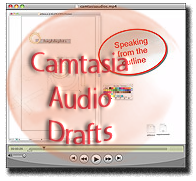 Once an
acceptable performance had been captured on the Mac using Snapz, the recording was
imported into Camtasia for Windows. More performance played out during the Camtasia stage through the development of the narrative
script. The first full audio narration take is mostly extemporaneous, with some guidance from journal sketches and an outline. The history of
computers and writing is recounted based on the sequence of my projects in the screen capture.
In the next audio take, the childhood memories have more presence in the narration. The decision to make things more personal is hard to trace
but in part emerges from transcribing the first improvisational performance of the voiceover.
Transcription became editing for concision which created gaps in the narration. How to fill them? More personal memories and educational experiences.
Once an
acceptable performance had been captured on the Mac using Snapz, the recording was
imported into Camtasia for Windows. More performance played out during the Camtasia stage through the development of the narrative
script. The first full audio narration take is mostly extemporaneous, with some guidance from journal sketches and an outline. The history of
computers and writing is recounted based on the sequence of my projects in the screen capture.
In the next audio take, the childhood memories have more presence in the narration. The decision to make things more personal is hard to trace
but in part emerges from transcribing the first improvisational performance of the voiceover.
Transcription became editing for concision which created gaps in the narration. How to fill them? More personal memories and educational experiences.
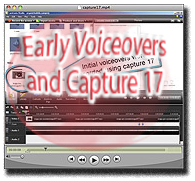 The second audio take was read from the revised transcript of the first. It is much cleaner, but still has some improvised and unfocused parts.
The manifesto is more directly integrated into the narration. If you listen to the entire take you can hear that at
about six minutes, I realize the recording is already a throwaway, but I want
to rework what I've developed so far into yet another revised transcript, so I keep going. I'm improvising and imagining adjustments, recording them aloud to be entered later in the emerging script.
The second audio take was read from the revised transcript of the first. It is much cleaner, but still has some improvised and unfocused parts.
The manifesto is more directly integrated into the narration. If you listen to the entire take you can hear that at
about six minutes, I realize the recording is already a throwaway, but I want
to rework what I've developed so far into yet another revised transcript, so I keep going. I'm improvising and imagining adjustments, recording them aloud to be entered later in the emerging script.
But things quickly looped back again toward performance on the screen. The first attempt to script and tune the screencast using Camtasia began with capture 17. Capture 17 must be redone when a typo in the final screen is recognized. I recorded multiple audio takes under the assumption that I was working with a clean capture of the screen performance. I was hesitant to return to performance mode because so many false starts and discards had already gone into what I thought was a complete take. The typo forced my hand. A good thing, because subsequent captures benefited from the new sense of timing and flow developed while working with drafts of the voiceover. And the personal dimensions of the project that emerge with the move to a new typing window in capture 21 never would have occurred without the looping back into performance performed by the typo in capture 17.
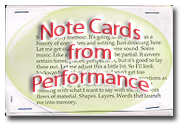
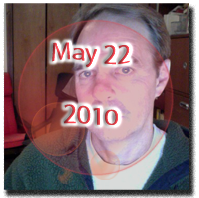 An early delivery
came on May 22, 2010, when I presented a version as a deliverator talk at the Computers and Writing conference.
That was my first public performance of the video. I read from note cards to deliver the narration while a copy of the
video with only the soundtrack played on a projection screen. I had practiced enough to know that there was some extra time at the end
of the video, so I filled that up by bringing up a text editor window on my screen while the last of the video played. In that window
I reiterated some of the questions raised during the video.
An early delivery
came on May 22, 2010, when I presented a version as a deliverator talk at the Computers and Writing conference.
That was my first public performance of the video. I read from note cards to deliver the narration while a copy of the
video with only the soundtrack played on a projection screen. I had practiced enough to know that there was some extra time at the end
of the video, so I filled that up by bringing up a text editor window on my screen while the last of the video played. In that window
I reiterated some of the questions raised during the video.
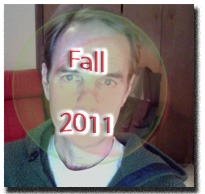
 It wasn't until the fall of 2011 that I began performing it again. I tried it out in class and did a read through with Ashley Hall.
Then I performed it at the University of Kentucky and then again at Duke University.
In each of those deliveries, the “Truing” video was performed and captured; then as the screen recorder began saving that performance, I launched into the memoir. The “Truing” piece would save, and then as the memoir was wrapping up,
I would open and begin playing the recording of the performance. Performance emerging,
then emergence performing.
It wasn't until the fall of 2011 that I began performing it again. I tried it out in class and did a read through with Ashley Hall.
Then I performed it at the University of Kentucky and then again at Duke University.
In each of those deliveries, the “Truing” video was performed and captured; then as the screen recorder began saving that performance, I launched into the memoir. The “Truing” piece would save, and then as the memoir was wrapping up,
I would open and begin playing the recording of the performance. Performance emerging,
then emergence performing.
(Video Transcript for Camtasia Audio Drafts)
(Video Transcript for Early Voiceovers and Capture 17)
(Video Transcript for Camtasia Audio Take Two)
(Video Transcript for May 22, 2010, Deliverator Presentation)